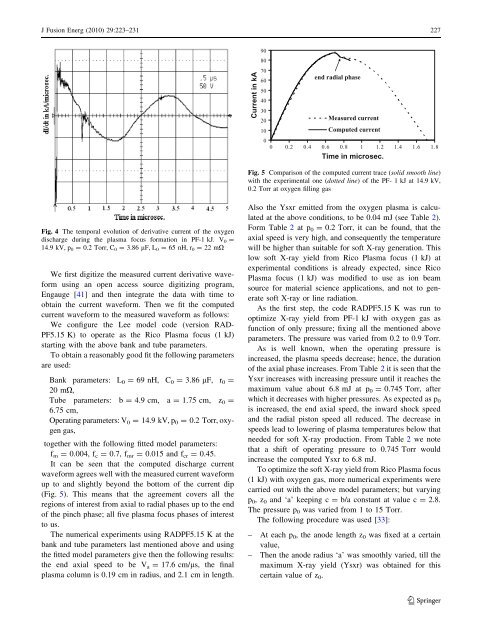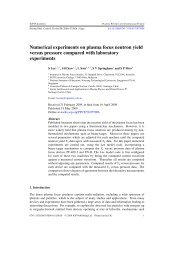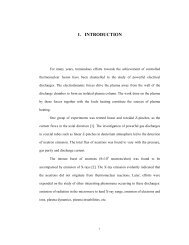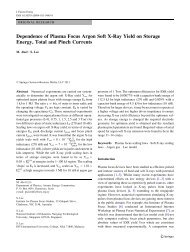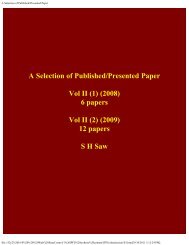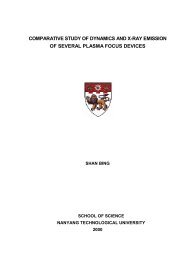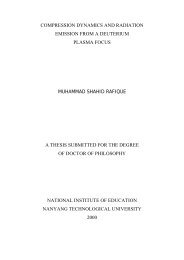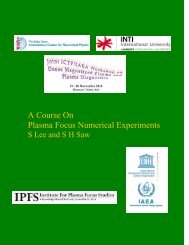- Page 1 and 2: A Selection of published/presented
- Page 3 and 4: The Universal Plasma Focus Facility
- Page 5 and 6: Response to “Comment on ‘Pinch
- Page 7 and 8: 1276 IEEE TRANSACTIONS ON PLASMA SC
- Page 9 and 10: 1278 IEEE TRANSACTIONS ON PLASMA SC
- Page 11 and 12: 1280 IEEE TRANSACTIONS ON PLASMA SC
- Page 13 and 14: 1282 IEEE TRANSACTIONS ON PLASMA SC
- Page 15 and 16: 023309-2 Lee et al. J. Appl. Phys.
- Page 17 and 18: 023309-4 Lee et al. J. Appl. Phys.
- Page 19 and 20: 023309-6 Lee et al. J. Appl. Phys.
- Page 21 and 22: IOP PUBLISHING PLASMA PHYSICS AND C
- Page 23 and 24: Plasma Phys. Control. Fusion 51 (20
- Page 25 and 26: Plasma Phys. Control. Fusion 51 (20
- Page 27 and 28: Plasma Phys. Control. Fusion 51 (20
- Page 29 and 30: IOP PUBLISHING PLASMA PHYSICS AND C
- Page 31 and 32: Plasma Phys. Control. Fusion 51 (20
- Page 33 and 34: Plasma Phys. Control. Fusion 51 (20
- Page 35 and 36: Plasma Phys. Control. Fusion 51 (20
- Page 37 and 38: Plasma Phys. Control. Fusion 51 (20
- Page 39 and 40: Plasma Phys. Control. Fusion 51 (20
- Page 41 and 42: J Fusion Energ DOI 10.1007/s10894-0
- Page 43 and 44: 224 J Fusion Energ (2010) 29:223-23
- Page 45: 226 J Fusion Energ (2010) 29:223-23
- Page 49 and 50: 230 J Fusion Energ (2010) 29:223-23
- Page 51 and 52: Neutron yield saturation in plasma
- Page 53 and 54: 151503-3 S. Lee Appl. Phys. Lett. 9
- Page 55 and 56: • Introduction Plan of Talk • D
- Page 57 and 58: 1971: David Potter published “ Nu
- Page 59 and 60: 1997 ICDMP (International Centre fo
- Page 61 and 62: Most important general property of
- Page 63 and 64: Diagnostics from modelling: The Mod
- Page 65 and 66: Imaging the Radial Phases of the Pl
- Page 67 and 68: a radius Radial inward shock phase
- Page 69 and 70: Plasma focus circuit
- Page 71 and 72: Dynamic Resistance depends on speed
- Page 73 and 74: The role of the current • Current
- Page 75 and 76: From Measured Current Waveform to M
- Page 77 and 78: Fitting computed Itotal waveform to
- Page 79 and 80: Current in kA Voltage in kV Diagnos
- Page 81 and 82: Speeds in cm/usec SXR Power in GW n
- Page 83 and 84: •.b
- Page 85 and 86: Desirable characteristics of a Mode
- Page 87 and 88: Insight into Neutron saturation •
- Page 89 and 90: Illustrating Yn ‘saturation’ ob
- Page 91 and 92: Comparing Itotal for small & large
- Page 93 and 94: Illustrating the dominance of DR0 a
- Page 95 and 96: We have shown that: constancy of DR
- Page 97 and 98:
Conclusions and Discussion Diagnost
- Page 99 and 100:
Conclusions and Discussion Beyond s
- Page 101 and 102:
Thank You Acknowledge contributions
- Page 103 and 104:
Appendix: Dynamic Resistance Consid
- Page 105 and 106:
certainly more consistent with all
- Page 107 and 108:
where for the temperatures of inter
- Page 109 and 110:
This compares to an earlier study c
- Page 111 and 112:
Conclusion Numerical experiments ca
- Page 113 and 114:
NUCLEAR&RENEWABLE ENERGY RESOURCES
- Page 115 and 116:
NUCLEAR&RENEWABLE ENERGY RESOURCES
- Page 117 and 118:
NUCLEAR&RENEWABLE ENERGY RESOURCES
- Page 119 and 120:
NUCLEAR&RENEWABLE ENERGY RESOURCES
- Page 121 and 122:
NUCLEAR&RENEWABLE ENERGY RESOURCES
- Page 123 and 124:
Fusion Energy and the Plasma Focus
- Page 125 and 126:
STARS:- Nature’s Plasma Fusion Re
- Page 127 and 128:
Natural Fusion Reactors vs Fusion E
- Page 129 and 130:
Introductory: What is a Plasma? Mat
- Page 131 and 132:
Major technological applications
- Page 133 and 134:
Scenario: World Population stabiliz
- Page 135 and 136:
Without a new abundant source of en
- Page 137 and 138:
Collisions in a Plasma The hotter t
- Page 139 and 140:
Isotopes of hydrogen- Fuel of Fusio
- Page 141 and 142:
Conversion of mass into Energy
- Page 143 and 144:
Summary of Conditions Technological
- Page 145 and 146:
Low Density, Long-lived Approach (M
- Page 147 and 148:
agnetic Yoke to induce Plasma Curre
- Page 149 and 150:
Inside JET
- Page 151 and 152:
Energy confinement time t scales as
- Page 153 and 154:
International Collaboration to deve
- Page 155 and 156:
ITER Construction has now started i
- Page 157 and 158:
FIRE: Incorporates Many Advanced Fe
- Page 159 and 160:
The other approach: Pulsed Super-hi
- Page 161 and 162:
Cross-sectional view of the KOYO-F
- Page 163 and 164:
• Plasma Focus (PF)- Introduction
- Page 165 and 166:
THE PLASMA FOCUS (PF) • The PF is
- Page 167 and 168:
Radial Compression (Pinch) Phase of
- Page 169 and 170:
Same Energy Density in small and bi
- Page 171 and 172:
Chart from M Scholz (November 2007
- Page 173 and 174:
Comparing generator impedance & Dyn
- Page 175 and 176:
At IPFS, we have shown that: consta
- Page 177 and 178:
Possible ways to improve Yn: Conclu
- Page 179 and 180:
Conclusion: • Tokamak programme i
- Page 181 and 182:
NUCLEAR&RENEWABLE ENERGY RESOURCES
- Page 183 and 184:
NUCLEAR&RENEWABLE ENERGY RESOURCES
- Page 185 and 186:
NUCLEAR&RENEWABLE ENERGY RESOURCES
- Page 187 and 188:
NUCLEAR&RENEWABLE ENERGY RESOURCES
- Page 189 and 190:
NUCLEAR&RENEWABLE ENERGY RESOURCES
- Page 191 and 192:
Latest Trends in Plasma Focus Fusio
- Page 193 and 194:
When matter is heated to high tempe
- Page 195 and 196:
Superior method for super-dense- ho
- Page 197 and 198:
z=0 Two Phases of the Plasma Focus
- Page 199 and 200:
Plasma Focus Devices in Singapore T
- Page 201 and 202:
Small PF, high rep rate for materia
- Page 203 and 204:
High Power Radiation from PF • Po
- Page 205 and 206:
Modern Status Now PF facilities (sm
- Page 208:
PF-1000, IPPLM, Warsaw Charging vol
- Page 211:
Computed Properties of the PF1000:
- Page 216 and 217:
PF-3 Experimental Setup- with plasm
- Page 218 and 219:
Experiments with liners Long radial
- Page 220 and 221:
KPF-4 (“PHOENIX”), SPhTI, Sukhu
- Page 222 and 223:
Some conclusions of plasma- wall in
- Page 224 and 225:
International Collaboration • Pla
- Page 226 and 227:
IAEA Co-ordinated Research Programm
- Page 228 and 229:
Chart from M Scholz (November 2007
- Page 230 and 231:
Comparing Itotal for small & large
- Page 232 and 233:
Comparing generator impedance & Dyn
- Page 234 and 235:
Confirming Ipeak saturation is due
- Page 236 and 237:
Insight- neutron saturation • A m
- Page 238 and 239:
Ongoing IPFS numerical experiments
- Page 252 and 253:
Plasma Focus Advanced Fuel Fusion
- Page 255 and 256:
Conclusions and Discussion Latest T
- Page 257 and 258:
Content • Thermonuclear fusion re
- Page 259 and 260:
Tokamak-planned nuclear fusion reac
- Page 261 and 262:
Introductory: What is a Plasma? Mat
- Page 263 and 264:
Major technological applications
- Page 265 and 266:
Scenario: World Population stabiliz
- Page 267 and 268:
Without a new abundant source of en
- Page 269 and 270:
Nuclear Fusion If a Collision is su
- Page 271 and 272:
Release of energy in Fusion
- Page 273 and 274:
Fusion Energy Equivalent 50 cups wa
- Page 275 and 276:
Energy-Demand and Supply: 3% demand
- Page 277 and 278:
1Q=10 18 BTU~10 21 J World reserves
- Page 279 and 280:
Thermalised parameter for D-T, D-D
- Page 281 and 282:
Mean free paths and mean free times
- Page 283 and 284:
Containing the Hot Plasma Long-live
- Page 285 and 286:
Schematic of Tokamak
- Page 287 and 288:
JET (Joint European Torus) • Proj
- Page 289 and 290:
JET X-Section
- Page 291 and 292:
Fusion Temperature attained Fusion
- Page 293 and 294:
ITER (International Thermonuclear E
- Page 295 and 296:
Q>10 and Beyond ITER : to demonstra
- Page 297 and 298:
Potential Next Step Fusion Burning
- Page 299 and 300:
Pulsed Fusion: Radiation Compressio
- Page 301 and 302:
Large scale Fusion Experiments •
- Page 303 and 304:
Superior method for dense pinches
- Page 305 and 306:
The Plasma Dynamics in Focus HV 30
- Page 307 and 308:
High Power Radiation from PF • po
- Page 309 and 310:
One of most exciting properties of
- Page 311 and 312:
Yn ‘saturation’ observed in num
- Page 313 and 314:
Confirming Ipeak saturation is due
- Page 315 and 316:
Insight- neutron saturation • A m
- Page 317 and 318:
Ongoing IPFS numerical experiments
- Page 319 and 320:
THANK YOU Appreciation to the follo
- Page 321 and 322:
Plan of Talk • Description of PF
- Page 323 and 324:
One method: electrical discharge th
- Page 325 and 326:
THE PLASMA FOCUS • The PF is divi
- Page 327 and 328:
Radial Compression (Pinch) Phase of
- Page 329 and 330:
Plasma Focus Devices in Singapore T
- Page 331 and 332:
300J PF: (2.4 µF, T/4 ~ 400 ns, 15
- Page 333 and 334:
Applications (non-fusion) SXR Litho
- Page 335 and 336:
3 4 1 2 5 6 7 8 9 10 PF SXR Schemat
- Page 337 and 338:
X-ray Micromachining
- Page 339 and 340:
Other Applications • Studies on R
- Page 341 and 342:
Most important general property of
- Page 343 and 344:
Modern Status Now PF facilities (sm
- Page 345 and 346:
PF 1000 ICDMP Poland-M Scholz
- Page 348 and 349:
An interesting trend-Numerical Expe
- Page 351 and 352:
Plasma Focus PF-3 Built in 1983 •
- Page 353 and 354:
12 C0 S Experimental set-up - Dust
- Page 355 and 356:
KPF-4 (“PHOENIX”), SPhTI, Sukhu
- Page 357 and 358:
Presented by A.Tartari, University
- Page 359 and 360:
UNU/ICTP Training Programmes AAAPT
- Page 361 and 362:
Neutron yields N against energy E,
- Page 363 and 364:
Insight into Neutron saturation •
- Page 365 and 366:
Illustrating Yn ‘saturation’ ob
- Page 367 and 368:
Comparing Itotal for small & large
- Page 369 and 370:
Illustrating the dominance of DR0 a
- Page 371 and 372:
We have shown that: constancy of DR
- Page 373 and 374:
Insight- neutron saturation • A m
- Page 375 and 376:
Conclusions and Discussion Yn satur
- Page 377 and 378:
Ongoing IPFS numerical experiments
- Page 379 and 380:
Plasma Fusion Energy Technology S L
- Page 381 and 382:
STARS:- Nature’s Plasma Fusion Re
- Page 383 and 384:
Natural Fusion Reactors vs Fusion E
- Page 385 and 386:
Introductory: What is a Plasma? Mat
- Page 387 and 388:
Major technological applications
- Page 389 and 390:
Scenario: World Population stabiliz
- Page 391 and 392:
Without a new abundant source of en
- Page 393 and 394:
Collisions in a Plasma The hotter t
- Page 395 and 396:
Isotopes of hydrogen- Fuel of Fusio
- Page 397 and 398:
Conversion of mass into Energy
- Page 399 and 400:
Summary of Conditions Technological
- Page 401 and 402:
Low Density, Long-lived Approach (M
- Page 403 and 404:
Magnetic Yoke to induce Plasma Curr
- Page 405 and 406:
Inside JET
- Page 407 and 408:
Energy confinement time t scales as
- Page 409 and 410:
International Collaboration to deve
- Page 411 and 412:
ITER A more detailed drawing
- Page 413 and 414:
Vacuum & Cryogenics Vacuum vessel:
- Page 415 and 416:
BLANKET: covers the interior surfac
- Page 417 and 418:
An extensive diagnostic system (50
- Page 419 and 420:
Plasma Heating • The temperatures
- Page 421 and 422:
Cooling and heat Transfer
- Page 423 and 424:
Q>10 and Beyond ITER : to demonstra
- Page 425 and 426:
Potential Next Step Fusion Burning
- Page 427 and 428:
Pulsed Fusion: Radiation Compressio
- Page 429 and 430:
Large scale Fusion Experiments •
- Page 431 and 432:
• Plasma Focus (PF)- - remarkably
- Page 433 and 434:
The Plasma Dynamics in Focus HV 30
- Page 435 and 436:
High Power Radiation from PF • po
- Page 437 and 438:
INTI UC Centre for Plasma Research
- Page 439 and 440:
Same Energy Density in small and bi
- Page 441 and 442:
One of most exciting properties of
- Page 443 and 444:
LogYn, Yn in 10^10 Global Scaling L
- Page 445 and 446:
Schematic of Plasma Focus Axial Pha
- Page 447 and 448:
Comparing generator impedance & Dyn
- Page 449 and 450:
IPFS-INTI UC Project: we have shown
- Page 451 and 452:
Beyond saturation?-to stimulate the
- Page 453 and 454:
This latest research breakthrough b
- Page 455 and 456:
THANK YOU Appreciation to the follo
- Page 457 and 458:
IOP PUBLISHING JOURNAL OF PHYSICS D
- Page 459 and 460:
J. Phys. D: Appl. Phys. 42 (2009) 0
- Page 461 and 462:
J. Phys. D: Appl. Phys. 42 (2009) 0
- Page 463 and 464:
J. Phys. D: Appl. Phys. 42 (2009) 0
- Page 465 and 466:
J. Phys. D: Appl. Phys. 42 (2009) 0
- Page 467 and 468:
Backward high energy ion beams from
- Page 469 and 470:
074506-3 Backward high energy ion b
- Page 471 and 472:
This article appeared in a journal
- Page 473 and 474:
Fig. 1. Layout of time resolved and
- Page 475:
Fig. 5. A “fitted” current trac


